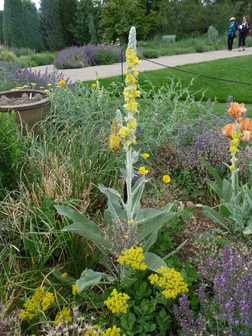Back to Tour: Medicinal Plants Tour
|
Verbascum bombyciferum 'Polarsommer' Arctic Summer Mullein; Silver Mullein |
Denver Botanic Gardens
Gardens Navigator 
|
|
Accession Number: 041896*1 Map | Images | |
| More about Verbascum bombyciferum 'Polarsommer' Arctic Summer | |
| TOUR DETAILS |
Medicinal Uses: Medicinally, mullein is a demulcent (relieves inflammation), emollient (softens skin), and astringent (helps dry oily skin). It also has slightly sedative properties. In the past mullein was smoked in pipes and made into cigarettes. It can also be combined into white wine for a more medicinal drink. The oil derived from mullein can help cure bites, bruises as well as ear-aches. Doctors recommend about 8 to 10 drops of tincture mixed with cold water, for the best effects. Mullein is also helpful in soothing inflamed bronchi during illness. Mythology/Folklore: It’s hard not to see a specimen of mullein if you’re hiking around Colorado as V. thapsus and V. blattaria are considered invasive weeds. The word “mullein” comes from the Latin malandrium, which is a type of sore or scab. The Latin name Verbascum comes from the word barbascum (a beard), which alludes to the plants hairy leaves. Humans enjoy the soft texture of the leaves of the plant, so much so that one of the nicknames of the plant is “wild toilet paper!” The plant is quite flammable and was used in previous centuries as a type of candle, giving it the epithet of “candlewick plant.” During this same period, it was believed that witches used these special candles in their incantations, which is why another name for this plant is “hag’s taper.” Medicinal recipe: Mullein tea : 1.5 cups of boiling water, 1-2 teaspoons of mullein leaves or flowers, 1 teaspoon of dried spearmint, 1-2 teaspoons of honey. Steep leaves or flowers in the boiling water for 15 minutes. Inhaling the steam from the boiling water can help to relieve coughs, cold symptoms, or asthma. Culture: Because mullein is an invasive weed within the Colorado region, it is not recommended for growing. |
| LOCATION GROUP | Water-Smart Garden |
| FAMILY NAME | Figwort Family |
| FAMILY | Scrophulariaceae |
| ACCESSION DATE |
July 08, 2004 (When this plant was acquired and registered in the database) |
| FLOWER COLOR | yellow |
| USDA HZ | 4 (Coldest Zone Where Hardy) |
| HABIT | Herbaceous (Non-woody) |
Location Map for 041896*1 Verbascum bombyciferum 'Polarsommer' Arctic Summer
Map Help
Flowering
When Verbascum bombyciferum 'Polarsommer' Arctic Summer has been observed flowering at Denver Botanic Gardens
 | ||||||||||||||||||||||||||||||||||||||||||||||||||||
| AVE. |  |
 |
 |
 |
 |
 |
 |
 |
 |
 |
 |
 |
 |
 |
 |
 |
 |
 |
 |
 |
 |
 |
 |
 |
 |
 |
 |
 |
 |
 |
 |
 |
 |
 |
 |
 |
 |
 |
 |
 |
 |
 |
 |
 |
 |
 |
 |
 |
 |
 |
 |
 |
| 2025 |  |
 |
 |
 |
 |
 |
 |
 |
 |
 |
 |
 |
 |
 |
 |
 |
 |
 |
 |
 |
 |
 |
 |
 |
 |
 |
 |
 |
 |
 |
 |
 |
 |
 |
 |
 |
 |
 |
 |
 |
 |
 |
 |
 |
 |
 |
 |
 |
 |
 |
 |
 |
| 2021 |  |
 |
 |
 |
 |
 |
 |
 |
 |
 |
 |
 |
 |
 |
 |
 |
 |
 |
 |
 |
 |
 |
 |
 |
 |
 |
 |
 |
 |
 |
 |
 |
 |
 |
 |
 |
 |
 |
 |
 |
 |
 |
 |
 |
 |
 |
 |
 |
 |
 |
 |
 |
| 2017 |  |
 |
 |
 |
 |
 |
 |
 |
 |
 |
 |
 |
 |
 |
 |
 |
 |
 |
 |
 |
 |
 |
 |
 |
 |
 |
 |
 |
 |
 |
 |
 |
 |
 |
 |
 |
 |
 |
 |
 |
 |
 |
 |
 |
 |
 |
 |
 |
 |
 |
 |
 |
| 2006 |  |
 |
 |
 |
 |
 |
 |
 |
 |
 |
 |
 |
 |
 |
 |
 |
 |
 |
 |
 |
 |
 |
 |
 |
 |
 |
 |
 |
 |
 |
 |
 |
 |
 |
 |
 |
 |
 |
 |
 |
 |
 |
 |
 |
 |
 |
 |
 |
 |
 |
 |
 |
Fruiting
When Verbascum bombyciferum 'Polarsommer' Arctic Summer has been observed fruiting at Denver Botanic Gardens
 | ||||||||||||||||||||||||||||||||||||||||||||||||||||
| 2018 |  |
 |
 |
 |
 |
 |
 |
 |
 |
 |
 |
 |
 |
 |
 |
 |
 |
 |
 |
 |
 |
 |
 |
 |
 |
 |
 |
 |
 |
 |
 |
 |
 |
 |
 |
 |
 |
 |
 |
 |
 |
 |
 |
 |
 |
 |
 |
 |
 |
 |
 |
 |
| 2014 |  |
 |
 |
 |
 |
 |
 |
 |
 |
 |
 |
 |
 |
 |
 |
 |
 |
 |
 |
 |
 |
 |
 |
 |
 |
 |
 |
 |
 |
 |
 |
 |
 |
 |
 |
 |
 |
 |
 |
 |
 |
 |
 |
 |
 |
 |
 |
 |
 |
 |
 |
 |
Images © Denver Botanic Gardens
 041896*1 Verbascum bombyciferum [Arctic Summer] = 'Polarsommer' |
 041896*1 Verbascum bombyciferum [Arctic Summer] = 'Polarsommer' |
| ^Top of Page |

© Denver Botanic Gardens, 1007 York Street, Denver, CO 80206
Photography © Denver Botanic Gardens

Powered by







 E-mail
E-mail